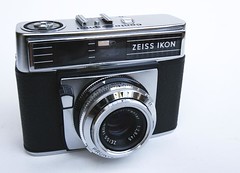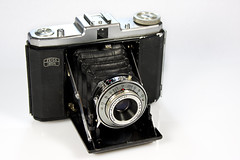Zeiss Ikon
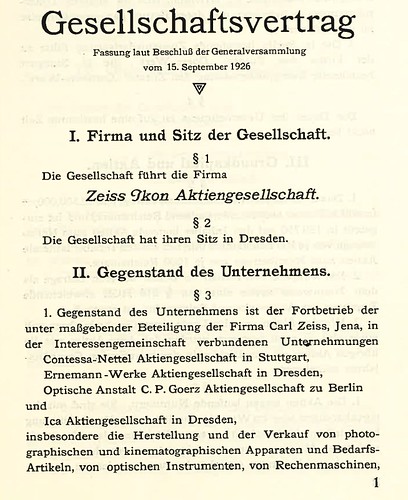
|
| Zeiss Ikon Foundation Paper, page 1 image by camerawiki (Image rights) |

|
| Zeiss Ikon and related companies |
| Pre-Merger phase I (before 1909) |
| Hüttig | Wünsche | Krügener | Carl Zeiss Palmos | Nettel | Drexler & Nagel | Herbst & Firl |
| Pre-merger phase II (1909-1926) |
| Carl Zeiss | Ernemann | ICA | Goerz | Zulauf | Contessa-Nettel |
| Zeiss Ikon (1926 and after) |
| Zeiss Ikon | Pentacon |
Zeiss Ikon is a German company that was formed in 1926 by the merger of four camera makers (Contessa-Nettel, Ernemann, Goerz and Ica), and an infusion of capital by Zeiss[1]. The company formed one part of the Carl Zeiss Foundation, another part being the optical company Carl Zeiss. Logically, most of the Zeiss Ikon cameras were equipped with Carl Zeiss lenses; and the formerly independent companies, in particular Goerz, had to shut down their own lens manufacture.
The merged company was also obliged to use Compur shutters for 80% of its cameras. Thus only the simplest cameras could get cheaper shutters like the Klio. Soon AG Hahn für Optik und Mechanik, Kassel, and Goerz Photochemisches Werk GmbH, Berlin, joined the Zeiss Ikon syndicate. Both companies, Zeiss Ikon and Hahn, were also in the business of producing keys, latches an lock cylinders. This business was more and more concentrated in the former optical factories of Goerz in Berlin.
The group became one of the big companies in the photo technology capital Dresden, with plants in Stuttgart and Berlin. It continued several products of its constituents for a while, but also created new ones like the quality folder Ikonta and the medium format rangefinder camera Super Ikonta. Until WWII Zeiss Ikon was the world's market leading maker of 8mm movie cameras. In addition to cameras and lenses, Zeiss Ikon also produced some optics for medical applications.
Contents
- 1 West Germany: Zeiss Ikon AG Stuttgart
- 2 East Germany: VEB Zeiss Ikon Dresden
- 3 After German reunification
- 4 35mm
- 5 120 film
- 6 127 film
- 7 Other film
- 8 Plate models
- 9 Model codes and image format
- 10 VEB Zeiss Ikon (Zeiss Ikon East)
- 11 Zeiss Ikon / Cosina
- 12 Light Meters
- 13 Flash
- 14 Movie Cameras
- 15 Other Optics
- 16 Bibliography
- 17 Notes
- 18 Links
West Germany: Zeiss Ikon AG Stuttgart
After World War II Zeiss Ikon was split into a West German and an East German part. It was reformed in West Germany, and trademark disputes followed with the part that was left in East Germany. Stuttgart became the company's domicile. Zeiss Ikon merged in the mid 1960s with Voigtländer, another important German manufacturer, and one that had been controlled by the Zeiss Foundation since 1956.
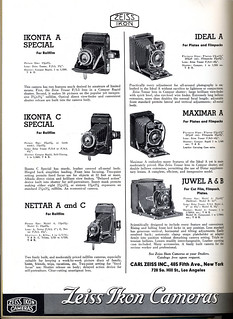
|
| 1938 ad scanned by Nesster (Image rights) |
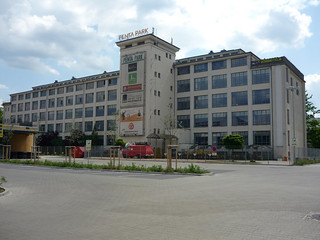
|
| Zeiss Ikon plant, built 1936 at Glashütter Straße in Dresden by Emil Högg, who was also architect of the Ernemann Tower image by Danipuntocom (Image rights) |
The product lines of Zeiss Ikon Stuttgart were different from the East German company's products. The Ikophot light meters were made in Stuttgart.
Zeiss Ikon ceased the production of cameras in 1972. This was a great shock for the entire German camera industry. Parts of the Zeiss Ikon product line then went to Rollei, and part of the know-how was used to revive the Contax name in collaboration with the Japanese maker Yashica.
Before reunification the whole Zeiss Ikon keys, latches & locking cylinder business was separated into a separate company.
East Germany: VEB Zeiss Ikon Dresden
| Photo industry in Stuttgart |
| Contessa | Contessa-Nettel | Drexler & Nagel | Ebner | Hauff | Kenngott | Kodak AG | G. A. Krauss | Nagel | Zeiss Ikon |
| Camera industry in Dresden |
| Balda | Certo | Eho-Altissa | Eichapfel | Ernemann | Feinmess | Heyde | Hamaphot | Huth | Hüttig | ICA | Ihagee | Kochmann | Kerman | KW | Eugen Loeber | Ludwig | Mentor | Merkel | Meyer | Mimosa | Pentacon | Richter | Sommer | Stübiger | Unger & Hoffmann | Werner | Wünsche | Zeiss Ikon | Zeh |
| Camera distributors in Dresden |
| Stöckig |
| Camera industry in Freital |
| Beier | Pouva | Stein & Binnewerg | Thowe | Welta |
Postwar production, begun early in May 1945, was soon interrupted as several factories were closed for dismantling their production machines. The machines were given as reparation to Soviet camera makers that had suffered demolition during the war. The production of the sophisticated Contax rangefinder cameras was prepared in Dresden and relaunched with new machines in Jena before all the machines were transferred to the Soviet camera maker Kiev. In 1948 the East German part of Zeiss Ikon became state owned. Production and development of Ernemann projectors and movie cameras were continued from 1949. Camera production was continued in 1947 with the Tenax and the Ikonta models. Soon the company's stock of leaf shutters was running out. In 1950 it could produce its own shutters since it took over the shutter production of Balda and the shutter factory of Mimosa. In 1952 the Tempor was Zeiss Ikon's first own leaf shutter development, followed in 1954 by the Prestor, the fastest leaf shutter at this time.
In 1948 the company could introduce its advanced SLR model, the Contax S. Since there were suits about trade mark names with the West German Zeiss Ikon AG, VEB Zeiss Ikon was renamed VEB Kinowerke Dresden in 1958. Later it became the main part of the East German combine Pentacon.
After German reunification
Today Carl Zeiss is reviving the Zeiss Ikon name. The new Zeiss Ikon camera, introduced at the 2004 Photokina show, is a rangefinder camera with Leica M-mount, developed in Germany and built by Cosina in Japan. Like the Contax G1 and G2), it has lenses made in both Japan (by Cosina) and Germany.
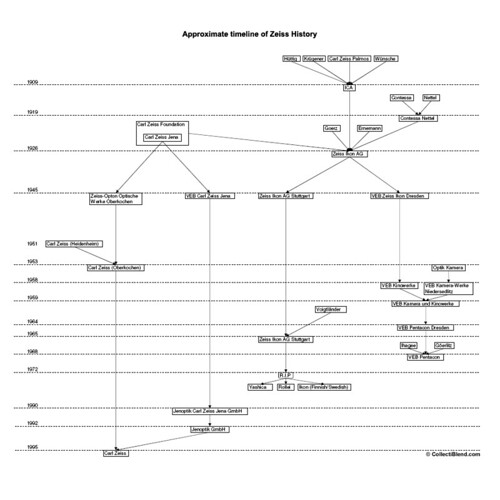
|
| Zeiss Ikon History Timeline Image by Eugene Ilchenko (Image rights) |
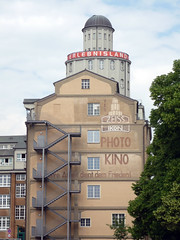
|
| Zeiss Ikon (East) Dresden plant with Ernemann Tower image by Danipuntocom (Image rights) |
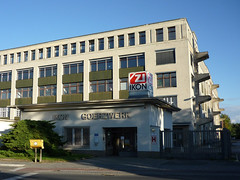
|
| Zeiss Ikon (West) Berlin plant Goerzwerk image by Danipuntocom (Image rights) |
35mm
Interchangeable Lens Rangefinder
| ||
|
Dresden
Stuttgart
Fixed Lens
- Contessa 35 (later models 1960-1973)
- Contessamatic, Contessamat
- Colora, Colora F
- Contina
- Continette
- Hologon Ultrawide (1971)
- Ikonette 35
- Symbolica
- Tenax Automatic
- Tenax I

|
| Contina II image by Alf Sigaro (Image rights) |
Folding
- Contina I / II
- Contessa 35 (1950-1955)
- Ikonta 35
- Super Nettel
- Super Nettel II
SLR
- Contaflex I (1953-1958)
- Contaflex II (1954-1959)
- Contaflex III (1956-1958)
- Contaflex IV (1956-1959)
- Contaflex Alpha (1957-1960)
- Contaflex Beta (1957-1958)
- Contaflex Prima (1959-1965)
- Contaflex Rapid (1958-1960)
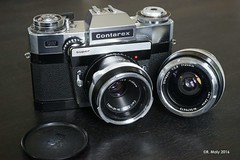
|
| Contarex Super image by René Maly (Image rights) |
- Contaflex Super (1959-1963)
- Contaflex Super (new) (1964-1966)
- Contaflex Super B (1962-1965)
- Contaflex Super BC (1965-1968)
- Contaflex S (1968-1971)
- Contaflex 126 (1967-1971)
- Contarex I ("Bullseye" or the "Cyclops")(1959-1966)
- Contarex Special
- Contarex Professional
- Contarex Super
- Contarex Super Electronic
Together with Voigtländer:
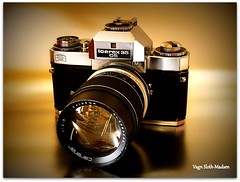
|
| Zeiss Ikon Icarex 35 CS TM image by Vagn Sloth-Madsen (Image rights) |
TLR
120 film
Folding
- Bob 510 (alternative name for Nettar 510)
- Simplex
- Lloyd
- Nettar
- Nettar II
- Nettax
- Icarette
- Cocarette
- Ikonta (follow link for all models)
- Super Ikonta (follow link for all models)
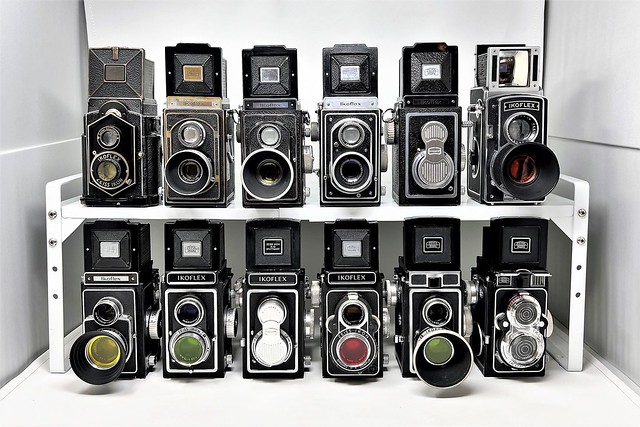
|
| Ikoflex Parade image by Randy Kroll (Image rights) |
TLR
- Ikoflex (850/16), first model (coffee can)
- Ikoflex I (850/16), later model (former Ikoflex II 851/16)
- Ikoflex Ia (854/16)
- Ikoflex Ib (856/16)
- Ikoflex Ic (886/16)
- Ikoflex II (851/16)
- Ikoflex II (852/16)
- Ikoflex IIa (855/16)
- Ikoflex III (852/16), became Ikoflex II in 1939
- Ikoflex III (853/16)
- Ikoflex Favorit (887/16)
- Tengoflex (85/16), pseudo TLR
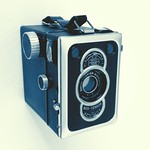
|
| Box Tengor image by Pinot & Dita (Image rights) |
Box
- Box Tengor
- Baldur (51 and 51/2)
- Erabox (52 and 52/2)
127 film

|
| Piccolette image by Dirk HR Spennemann (Image rights) |
- Baby Box Tengor
- Cocarette 519/14 (Baby Cocarette)
- Ikonta 520/18 (Baby Ikonta)
- Ikonette (folding, 127, c.1929)
- Kolibri
- Piccolette
- V.P. Icarette
Other film
Plate models
Folding bed

|
| Tropen Adoro image by Geoff Harrisson (Image rights) |
- Donata, carried over from Contessa-Nettel
- Favorit
- Ideal 250/3 (6.5×9cm)
- Ideal 250/7 (9×12cm)
- Ideal 250/9 (10×15cm)
- Ideal 250/11 (13×18cm)
- Maximar A (6.5×9) & B (9×12)
- Onito 127/6 (9x12cm)
- Orix / Trix (10×15)
- Taxo 122/3 & 126/3 (6.5×9cm)
- Taxo 122/7 & 126/7 (9x12cm)
- Trona (9×12)
- Tropen Adoro (four sizes)
- Tropica (9x12, 10x15, 13x18)
- Universal Juwel A (9×12) & B (13×18)
- Victrix (4.5x6)
- Volta (9×12)
Strut folding
- Bebe
- Deckrullo-Nettel
- Nettel (strut-folding)
- Miroflex A (6.5×9) & B (9×12)
- Sonnet
- Stereax
Box
Model codes and image format
Before 35mm film became the general standard, the image format was encoded in the last number of the model number (e.g.: 227/7 for a 9x12cm Donata) [2]
| code | format |
|---|---|
| 1 | 4.5x10.7cm plate (stereo) or 8x10.5cm rollfilm |
| 2 | 6x9cm on 120 (8 exposures) |
| 3 | 6.5x9cm sheet/plate |
| 4 | 6x13cm |
| 5 | 8.5x11.5cm plate |
| 6 | 8x14cm rollfilm (Kodak 122/3A) or 9x14cm (5.5x3.25") sheet or |
| 7 | 9x12cm sheet/plate |
| 9 | 10x15cm sheet/plate |
| 11 | 13x18cm (5x7 inch) sheet/plate, for US/UK market? |
| 12 | 4x6.5cm on 127 (8 exposures) |
| 14 | 5x7.5cm on 129 film |
| 15 | 6.5x11cm on 116 |
| 16 | 6x6cm on 120 (12 exposures) |
| 17 | 8x10.5 cm (quarter plate 3.25 x 4.25") |
| 18 | 3x4cm on 127 (16 exposures) |
| 20 | 18x24cm sheet/plate |
| 24 | 2.4x3.6cm on 135 (standard 35mm) |
| 27 | 2.4x2.4cm on 135 |
VEB Zeiss Ikon (Zeiss Ikon East)
35mm SLR
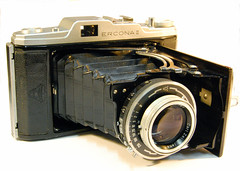
|
| Pentacon Ercona II image by Hans Kerensky (Image rights) |
- Contax E or Pentacon E
- Contax F or Pentacon F
- Contax FB or Pentacon FB
- Contax FM or Pentacon FM
- Contax FBM or Pentacon FBM
35mm Fixed Lens
120 folder
Zeiss Ikon / Cosina
- Zeiss Ikon (rangefinder camera)
- Zeiss Ikon SW (viewfinder)
Light Meters

|
| Ikophot 53 image by Anssi Puisto (Image rights) |
- Diaphot (optical meter)
- Helicon
- Helicon (large model, combined with rangefinder)
- Helios
- Ikophot
- Ikophot 51
- Ikophot 53
- Ikophot CD
- Ikophot M
- Ikophot Rapid
- Ikophot S
- Ikophot T
- Kidiaphot (Cine version of Diaphot)
Flash
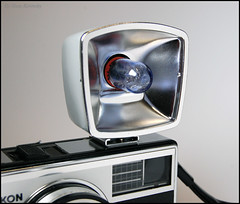
|
| Zeiss Ikon Ikoblitz LD image by Hans Kerensky (Image rights) |
- Ikoblitz 4
- Ikoblitz 5
- Ikoblitz 6
- Ikoblitz LD
Movie Cameras
Other Optics
In addition to cameras and lenses, Zeiss Ikon also produced film and slide projectors, as well selected optics for medical applications
Film Projectors
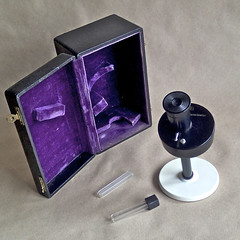
|
| Zeiss Ikon Blutzucker-Kolorimeter D. image by Dirk HR Spennemann (Image rights) |
- 16 mm Projector (1943)[6]
- Kinox B Schmalfilmkoffer Projektor
- Kinox N375 - 16 mm Projector (1937)[6]
- Model W26615 - 16 mm Projector (1931)[6]
- Model W38553 - 16 mm Projector (1935)[6]
- Movilux 8 mm Projector (1959)[6]
- Movilux R 8mm Projector[7]
Slide Projectors
- Perkeo automatic S 150[8]
- Perkeo 315AF
- Perkeo 315IR
- Perkeo 315AV
- Royal AF Selectiv IR slide projector
Medical applications
- Blutzucker-Kolorimeter D (blood sugar measuring device) 1928-1950s[9]
Bibliography
- Barringer, C. and Small, M. Zeiss Compendium East and West. 1940–1972. UK: Hove Books, 2nd edition, 1999. ISBN 1874707243.
- Dechert, Peter. The Contax Connection. Historical Camera Publications, 2007. Available for download in PDF at Peter Dechert's Corner (archived)
- Tubbs, D. B. Zeiss Ikon Cameras. 1926-39. UK: Hove Books, 1993. 190 pages. ISBN 1874707014.
Notes
- ↑ Reputedly, the word Ikon came from ICA and Contessa-Nettel, two of the constituents in the merger. Other sources claim that it is derived from the Greek, meaning image/picture.
- ↑ source: Franz Steimer: Fotoliste 2007/2008; via https://camera-info.de/fotocommunity/threads/modellbestimmung-zeiss-icon-icarette.81235/#post-558902
- ↑ Butowskis Auctions
- ↑ Movikon 8
- ↑ Description
- ↑ 6.0 6.1 6.2 6.3 6.4 Zeiss Ikon page at Binocuclars and Cine Collectors
- ↑ Youtube
- ↑ Seen on eBay 2012
- ↑ Zeiss Ikon Blutzucker-Kolorimeter D Dirk HR Spennemann via Flickr
Links
In English:
- The Zeiss Historica Society (archived)
- Zeiss Historica publications
- The Zeiss Ikon Collectors Group
- Klaus-Eckard Riess's story, former Zeiss-Ikon (East AND West) employee
- Zeiss Ikon instruction manuals in butkus.org's Library
- Holoceen
- Zeiss Ikon Price Guide at CollectiBlend
- Zeiss Ikon patents
In German:
- cameras of Zeiss-Ikon's predecessors at Klaus-Eckard Riess homepage
- Company history at dresdner-kameras.de
- Story of Zeiss Ikon at phototechnik-online.de by Gerd Jehmlich (archived)
- Images of Zeiss Ikon cameras at www.amuseum.de
- East German leaf shutters
In French:

